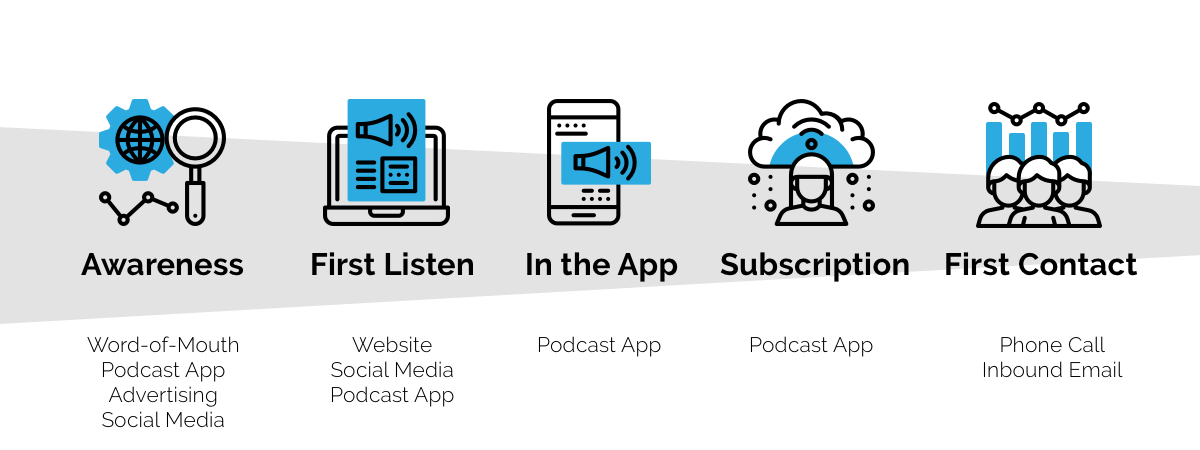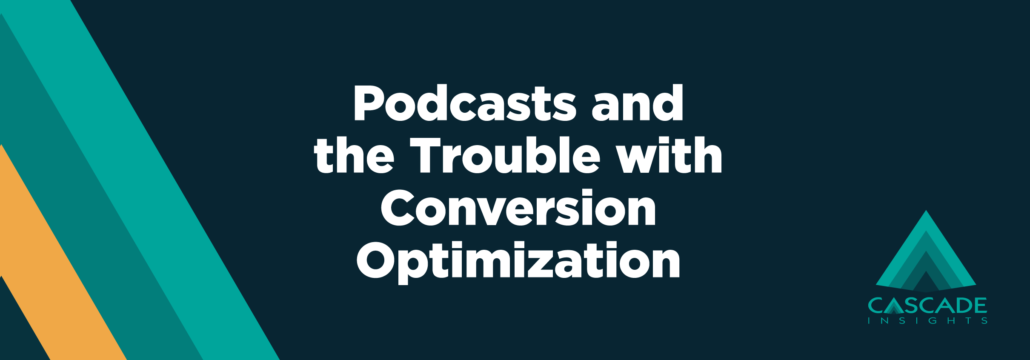Podcast marketing advice tends to be overly simplistic and unhelpful. For example: “Once they’ve followed you on Twitter, send them to Apple Podcasts and get them to subscribe to your show.” Such flippant recommendations get tossed around a lot. However, the complexities of the podcast conversion funnel are far greater than they initially appear.
What follows serves as a guide to understanding the podcast conversion funnel, how it differs from a standard content marketing funnel, and how it ultimately converts listeners into qualified leads. Understanding it is one of the most fundamental pieces to understand if you want your podcast to succeed.

The Podcast Conversion Funnel
For most B2B marketers, optimizing a conversion funnel requires:
- Data analysis, which enables marketers to make decisions based on quantitative data.
- Customer research, which enables marketers to make decisions based on qualitative feedback.
Unfortunately for most companies, the world of podcasting doesn’t fully offer either of these. Data is available, but it’s almost entirely anonymized. Qualitative feedback is available, but it relies on listeners reaching out to you. That makes the podcast conversion funnel difficult to optimize, since you can’t entirely rely on great data or knowing who is listening at any particular stage.
How Does The Funnel Work?
It starts when people become aware of your podcast. That can be the result of seeing a post of yours on LinkedIn, by one customer sharing it with another potential customer, or in any one of a hundred other ways. The podcast conversion funnel is further obscured by not knowing who is listening to your podcast, since most podcast players don’t provide data on subscribers or on listening behaviors.
Then there is the big leap from initial discovery to deciding to open a podcast app. It involves going from Desktop to Mobile, browsing to engaging, and passive to active participation. If that big leap happens, they’ll ideally subscribe to your show.
Finally, as a business, you want to translate those engagements into known contacts.To do that, listeners will have to leave the podcast application and get in touch with you. Optimizing for their preferred method of contact is also a challenge. Do they prefer email? A phone call? A form fill?
It’s the complexity of this funnel that makes most podcasting advice seem out of touch. Saying something like, “once they discover your show, get them to subscribe to your show” is as useful as saying, “when you get to Europe, say ‘hi’ to my friend Jacques” with no additional guidance on who Jacques is.
Good luck with that.
Understanding the Funnel Is Half the Battle
With podcasting, luck isn’t enough. Instead, our advice is to prioritize the parts that you can measure and have the greatest value.
Here’s a handy breakdown of each stage of the funnel:
| Stage | Measurable? | Value | Notes |
| Awareness | No | Low | You can’t measure who becomes aware of your podcast in the same way you know how many people viewed a blog post. Podcast awareness happens in thousands of locations, most of which aren’t instrumented for tracking on a per-listener level. In addition, the value of this stage isn’t particularly high, since awareness doesn’t necessarily lead to becoming a client. |
| First Listen | No | Medium | The first time someone listens to your podcast might be on social media, YouTube, your website, or a podcast player. Each provides different levels of analytics. For example, you could see the number of viewers who saw your tweet, while a podcast app will tell you how many downloads you receive but not how many people viewed your podcast.While you may not know who is listening, there is some value in improving conversion at this stage of the funnel. After all, the adage of “first impressions matter” is especially true in podcasting. |
| In the App | Yes | High | You can measure if people are visiting a podcast app for your podcast in two ways. First, you can track clicks from links you have on your website. Second, you can look at the weekly download numbers per user agent, which is provided by most podcast hosts. Similarly, the expected value here is quite high, since they’re clearly interested enough to open a third-party app to listen to your show. |
| Subscription | Partially | High | There are ways to measure the number of subscribers you have in Apple Podcasts, Overcast, and a handful of other podcasting apps. However, you’ll never get a complete number of subscribers or any information on who those subscribers are. While the subscriber data is mostly incomplete, the value of a subscriber is incredibly high. That’s because they’re not only interested in your show, but they’re also automatically downloading future episodes onto their personal devices. |
| First Contact | Yes | High | Being contacted by someone listening to your show is both very measurable (you have a new lead) and has a very high expected value (they’re talking to you). However, to fully take advantage of this value, you need to make sure your marketing and sales teams are aligned on tracking these touch points. |
The big takeaway is that the two highest priority stages of the podcast conversion funnel are App Open and First Contact. From the perspective of getting the best bang for your buck, these two stages typically have the most to offer. (That’s not to say that the other stages aren’t important.)
A caveat: this will change as more podcast apps share information about who is subscribing to your show. But we’re not quite there yet. In the past month, we had more than 60 apps play our podcast, with only a handful of apps reporting subscriber data.
As with all conversion optimization and lead generation, some of the most valuable work you can undertake is to reduce friction from one stage of the funnel to another.
In the App Stage
By the time someone has listened to your podcast, much of your work is done. But, you still need to get them to open a podcast app and subscribe to your show. Logistically speaking, that means that wherever they’re listening to your show (social media, your website, etc.), you need to have a link pointing them to the relevant podcast apps.
For something as mundane as linking to a podcast, there are two opposing schools of thought: glass half-full and glass half-empty.
The Half-Full school optimistically believes that most people will have a preferred podcast app on their phones and that they’ll want to view your show on that app. So, they provide a grid of links pointing to all of the major podcasting apps. Which is no small number, as there are dozens of active podcast apps.
The Half-Empty school looks at the data saying most people have never listened to a podcast and believes that they should only rely on pre-installed podcast apps. So, they provide a link to Google Podcasts for Android users and Apple Podcasts for iOS users.
Personally speaking, they both have some merit. Deciding on one avenue vs. another relies on understanding the target audience for your podcast. Are they technologically savvy? They likely have a preferred app. Are they less tech savvy? The default apps will likely work fine.
Either way, one tool we use for our show, the B2B Revealed Podcast, is Branch. It has many applications, but the relevant one here is that you can create a link that will redirect based on the type of device the user is using. As an example, if you click this link to our interview with Dr. Bhaskar Chakravorti it will open Apple Podcasts on an iOS device, Google Podcasts on an Android device, and our website on any desktop device. Simple tweaks like that can create a great experience for your listeners.
The First Contact Stage
Seeing your monthly download numbers go up and to the right can be a wonderful feeling. Yet, if none of those people are converting to customers, what’s the point? That’s why it’s so crucial to pay attention to the First Contact stage.
There are three common ways that brands grease this stage of the funnel: gating, advertising, and participation.
Closing the Gate
Some brands use their podcast as a teaser for content that’s locked behind a content gate. For example, if you have a podcast where you’re interviewing experts in your industry, you could post the first 10 minutes of the interview in your public feed and then explain that the full hour-long interview is available on your website in exchange for an email address.
The upside here is that you’ll gather contact information from those who want to listen to the entire podcast. The downside is that you’re effectively producing two different podcast feeds. That may not be worth the effort, as many of the leads will be unqualified and unready for any serious discussion about using your products or services. They are leads, yes, but the value is a bit lower.
Self-Advertising
Another way that companies increase the conversion is by advertising their company as the sponsor and creator of the podcast. Since it’s rare for people to want to listen to a company talk about themselves all day long, most successful branded podcasts focus on larger themes than a self-centered pitch.
Still, many listeners will be unaware what your company is or what you provide. By inserting a 30-second advertisement for your own company in the middle or end of every episode, you’ll increase awareness and conversion. For example, on our podcast, we put in an audio clip that sounds like this:
Audience Participation
Finally, getting your audience to participate in the creation of an episode is a great way to transform podcasting from a one-way broadcast channel into a two-way conversation.
For example, we’ve recently begun soliciting questions for our guest experts on B2B Revealed. This gives clients and listeners the benefit of asking experts questions about marketing and marketing research. It also allows us to engage with clients in a more meaningful way and gives listeners new perspectives on topics we cover.
Funnel Tunnel Vision
Without understanding your conversion funnel, your podcast will meander along without clear direction.
But, if you spend some time understanding and optimizing your conversion funnel, you’ll end up with a clear idea of what needs to be done to get your podcast in the ears of the right people.
Need help launching or optimizing a business podcast? Check out our B2B podcast production services.
With custom market research and marketing services, Cascade Insights helps companies seize opportunities in the B2B technology sector. We work with everyone from enterprise tech stalwarts to up-and-comers in fields such as FinTech, MarTech, Health Tech, and more.

